

Translation of
Published by the JewishGen Press
Original Yizkor Book Edited by: D. Rabin
Available from
for $37.00
Project Coordinator: Michael Palmer
Layout and Name Indexing: Jonathan Wind
Reproduction of Photographs: Sondra Ettlinger
Cover Design: Nina Schwartz
Hard Cover, 8.5” by 11”, 428 pages with original photographs
 |
Details:
Krynki, located on an important route between Kraków and Grodno, had a significant Jewish presence since the 17th century. Josif Giel established a wool and flannel factory here in 1827; it was soon joined by other factories, including 14 leather tanneries and 8 leather works. By the end of the 19th century, Krynki had about 5,000 inhabitants, 88-90% Jewish. The community had five synagogues, two Hasidic prayer houses, over a dozen cheders, a yeshiva, a hospital and nursery, and social and aid organizations such as Linas Hatzedek and Bikkur Cholim. There were Jewish schools and sports clubs, Zionist organizations, and labor unions. In June 1941 the Nazis occupied Krynki and began a reign of brutality and murder. In December 1941, a ghetto was set up where the entire Jewish population, as well as Jews from nearby areas, were forced to live. Liquidation of the ghetto began in October 1942; 5,000 Jews were deported to the camp in Kolbassino. Some resisted, firing stolen rifles and revolvers; several escaped to the forest. The few Jews left after the deportation were finally sent to the extermination camp in Treblinka. Today, no Jews live in Krynki, but the memory of them lives on. This book was written “to bring forth the history of this martyred community... its founding, industrial power, struggles, fights, and revolts.” May this book serve as a memorial to those who lived in Krynki. Krynki, Poland is located at: 53°16' / 23°47' Alternate names of the Town: Krynki [Pol, Rus], Krinek [Yid], Krienek, Krinki, Krinok Nearby Jewish Communities:
Odelsk, Belarus 9 miles N |
 JewishGen Press
JewishGen Press
 JewishGen Home Page
JewishGen Home Page
Copyright © 1999-2025 by JewishGen, Inc.
Updated 17 Oct 2022 by LA